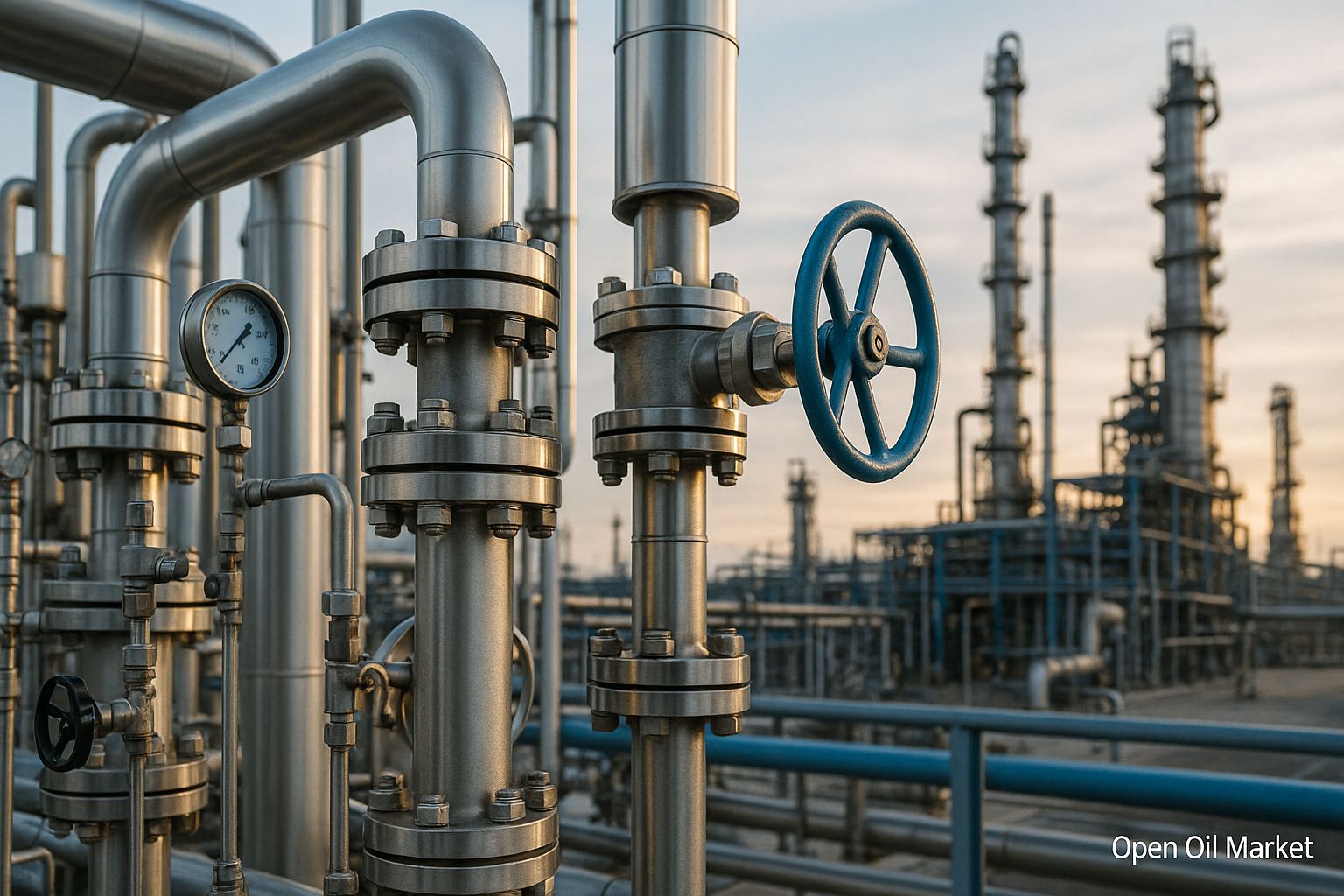
Current News in the Oil, Gas, and Energy Sector for Saturday, November 22, 2025: Peace Initiatives Pressuring Oil, Gas Market Ahead of Winter Peak, Sanctions, Renewables, Coal, and Refining. Analysis for Investors and Energy Companies.
As Saturday, November 22, 2025, unfolds, participants in the global energy market find themselves navigating a contradictory landscape. Oil prices remain under pressure within a relatively low range—Brent quotes are holding around $62–63 per barrel after a week of decline, reflecting an oversupply and signals of potential peace negotiations surrounding Ukraine, which are reducing the geopolitical premium in prices. The European gas market is entering the heating season with still high, albeit not record levels of stockpiles, offering a buffer and preventing sharp price spikes.
Simultaneously, Asian importers are closely monitoring LNG prices. The situation is complicated by sanctions: the enforcement of new restrictions against Russian oil and gas companies is forcing a reevaluation of oil and oil product export routes. Meanwhile, the global energy transition is gaining momentum—investments in renewables and electric power are reaching new highs, although oil, gas, and coal continue to comprise the foundation of the global energy supply.
Global Context: Oversupply and Modest Demand for Energy Resources
In 2025, the global energy sector is characterized by both steady but moderate demand growth and increasing supply. For investors, the key question remains the balance of oil and gas amid high interest rates and slowing global economic growth.
- Oil. After significant fluctuations in the fall, prices for Brent and WTI have stabilized around $60–64 per barrel. The market is anticipating a scenario of oversupply due to the gradual increase in production by OPEC+ countries and rising supply from the US, Brazil, and other nations.
- Gas. The European market is entering winter with comfortable gas storage levels (approximately 75% of maximum capacity), which is below last year's record levels but sufficient for the start of the season. Even in the case of harsh weather, gas withdrawal may accelerate, potentially causing price increases.
Oil Market: Sanctions, Discounts, and New Export Routes
As of November 22, 2025, the attention of the oil market is focused on geopolitical factors and their impact on Russian exports. In the face of escalating sanctions, Moscow is compelled to offer deeper discounts on its oil to maintain supplies to Asian, Middle Eastern, and African countries. Major Indian refineries have announced a suspension of purchases of Urals crude following the sanctions deadline, increasing pressure on Russian suppliers to seek alternative buyers. Consequently, the global oil market is effectively splitting into different pricing tiers, and traditional trading flows are being redirected along new routes.
- Production and Quotas. OPEC+ countries have not yet signaled any new production cuts, limiting themselves to cautious statements. At current prices, most producers remain profitable; however, they fear further market oversaturation.
- Price Structure. Near-term Brent oil futures are trading lower than contracts for later months (contango is observed), reflecting expectations of oversupply in the short term. Such a structure poses risks for long-term projects, reducing investment incentives, while benefiting consumers through lower spot market prices.
- Investments. Major oil companies in North America, the Middle East, and the Atlantic continue to develop only the most cost-effective fields, approaching new capital expenditures with great caution in light of intensified climate requirements.
Gas Market: Europe, Asia, and the Role of LNG
Gas remains the key fuel of the transitional period between traditional energy sources and renewables. In 2025, the natural gas market is shaped by three main factors: stock levels, electricity demand, and geopolitical constraints.
- Europe. EU countries are approaching winter with gas storage levels around 75%—below last year's levels but still sufficient for the beginning of the season. In the event of an extremely cold winter, fuel withdrawal could sharply increase and trigger price spikes.
- Asia. In China and other Asian countries, increased domestic production and long-term LNG contracts are reducing the market's sensitivity to price spikes. However, with a sudden increase in demand, competition between Asia and Europe for available LNG shipments could flare up again.
- LNG Market. The commissioning of new LNG export capacities in the US, Qatar, and East Africa is ongoing, altering global gas flows. For investors, this signifies the rising importance of projects tied to global gas indices and the necessity to consider not only local but also interregional pricing trends.
Electricity and Coal: High Loads and Climate Constraints
The electricity sector in 2025 showcases steady consumption growth against a backdrop of digitalization and the electrification of transport and industry. At the same time, coal, despite environmental pressures, remains a key source of generation in many countries, particularly in developing states.
- Electricity. Energy companies in Europe and the US are preparing for possible winter consumption peaks by increasing backup capacity and modernizing networks. As the share of renewables rises, maintaining the stability of energy systems is becoming a primary strategic task.
- Coal. Global coal consumption in 2025 has shifted from a growth phase to a stabilization phase. Stricter environmental regulations and the proliferation of renewables are prompting mining companies to optimize costs and delay the launch of new mines.
- Regulation. Many countries are introducing additional carbon payments and quotas to stimulate the transition away from coal in favor of gas and renewable energy. These measures are directly affecting the structure of generation and the pricing dynamics of the electricity sector.
Renewables and Energy Transition: Record Investments and New Challenges
Renewable energy sources are the primary beneficiaries of the global energy transition. In 2025, investments in "green" energy and the modernization of power grids are reaching historic highs, surpassing the scale of investments in the fossil sector. This intensifies the competition between traditional fuel and energy sectors and new clean energy initiatives.
- Investment Trends. Global investments in solar and wind energy, storage systems, and infrastructure in 2025 are nearing total investments in oil, gas, and coal. This pressures the margins of traditional energy companies and compels them to diversify their business models more rapidly.
- Technologies. The active development of industrial energy storage, hydrogen projects, and digital demand management systems is emerging as a key growth driver. New solutions enable more effective integration of renewables into energy systems and reduce the necessity for peak gas and coal generation.
- Regional Gap. The majority of "green" investments are concentrated in developed economies and China, while developing countries face a capital shortage for environmentally friendly projects. This opens a niche for international financial institutions and private investors willing to invest amidst heightened country risks.
Petrochemicals and Refineries: Stable Margins and Domestic Price Policies
The petroleum products market by the end of 2025 is demonstrating a more stable situation compared to the beginning of the year. For refineries (refineries) in Europe, Asia, Russia, and the Middle East, the key task remains flexible management of capacity utilization and product assortment.
- Refining Margins. Moderately low oil prices with stable demand for diesel and jet fuel are supporting high profitability for refining. This encourages plants to increase the utilization of modern facilities, especially in regions with developed export logistics.
- Domestic Markets. In many countries (including Russia), protective measures for the domestic fuel market continue to be in place—export restrictions, reverse excise taxes ("dampers"), price controls at gas stations. These mechanisms impact refinery operations, forcing them to balance export and domestic demand fulfillment.
- Environmental Standards. Strict fuel quality requirements (low sulfur content, reduced emissions) are stimulating new investments in refinery modernization—hydrocracking units, deep refining, enhanced environmental processes. For investors, it's crucial to calculate the returns on such investments considering the potential introduction of carbon taxes.
Conclusion for Market Participants: Key Points for November 22, 2025, and Beyond
As we approach the end of 2025, it is particularly important for investors and companies in the fuel and energy sector to find a balance between short-term circumstances and long-term energy transition trends. Oil and gas quotes remain moderate, investments in renewables have reached record levels, and the pressures of sanctions and regulatory uncertainties create a complex yet largely predictable agenda.
- In the short term, it is advisable to focus on the development of the sanctions situation, the dynamics of winter energy demand, and OPEC+ decisions regarding production levels.
- In the medium term, critically assess the resilience of energy companies' business models to tightening climate policies and the increase in the share of renewables in the energy mix.
- Diversification remains a key strategy: a combination of quality oil and gas assets, infrastructure (pipelines, LNG terminals, electricity grids), and growing segments of renewable energy allows for risk distribution and maintaining competitive advantages.
Thus, Saturday, November 22, 2025, showcases a fragile equilibrium in the oil and gas and energy markets: fundamental indicators remain relatively stable, yet geopolitical and environmental agendas demand heightened vigilance and flexibility in decision-making from participants.




